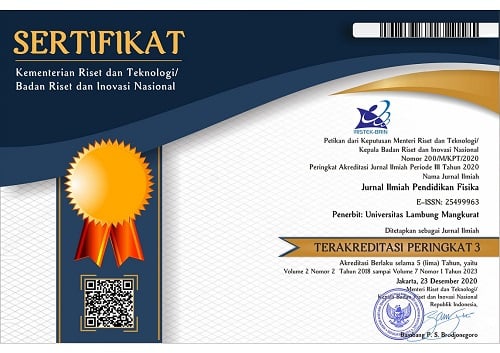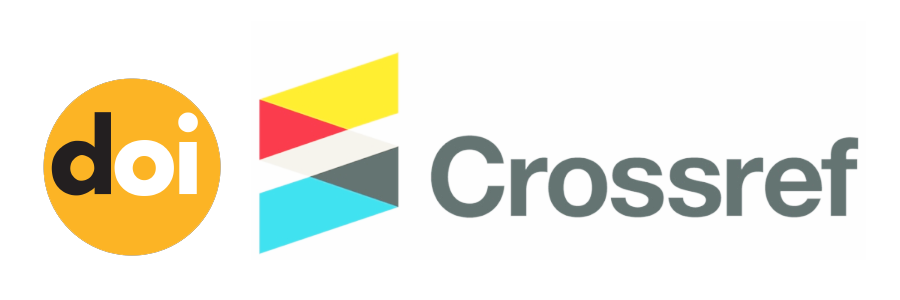Program Resitasi Materi Vektor sebagai Alternatif Pengganti Tatap Muka di Masa Pandemi Covid-19 untuk Meningkatkan Penguasaan Konsep Siswa
Abstract
Vektor merupakan salah satu topik penting dalam fisika karena seringnya dijumpai pada topik-topik fisika lainnya. Akan tetapi, sejumlah penelitian terdahulu menunjukkan bahwa pemahaman konsep vektor siswa masih rendah. Beberapa upaya yang telah dilakukan diantaranya penggunaan multirepresentasi verbal dan matematis, pembelajaran berbasis masalah, dan penggunaan media serta sumber belajar daring. Tujuan dari artikel ini adalah untuk mendeskripsikan pengembangan resitasi pada materi vektor dengan mengangkat sejumlah solusi terdahulu yang dapat digunakan di masa pandemi. Jenis penelitian yang digunakan adalah penelitian kepustakaan atau library research dengan metode analisis deskriptif. Berdasarkan hasil studi kepustakaan, diperoleh suatu metode yang dapat meningkatkan penguasaan konsep siswa, yaitu resitasi berbasis program. Metode tersebut merupakan suatu penugasan kepada siswa yang dirancang dengan umpan balik pada setiap jawaban siswa. Pengalaman penggunaan resitasi terbukti dapat meningkatkan pemahaman konsep fisika siswa secara signifikan. Rata-rata peningkatan dari pre-test ke post-test pada penelitian-penelitian terdahulu sebesar 14,5. Resitasi juga dapat menjadi pengganti guru di luar jam pembelajaran, sehingga dapat dijadikan sebagai alternatif pengganti tatap muka pada masa pandemi.
Vector is one of the prominent topics in physics because it is often found in other physics topics. However, many previous studies show that students' understanding of vector concepts is still low. Some of the efforts that have been made include verbal and mathematical multi-representations, problem-based learning, and the use of media and online learning resources. This article describes the development of recitation in vector material by highlighting several previous solutions that may be used during a pandemic. The type of this research is library research or library research with descriptive analysis methods. Based on the literature study results, a method that can improve students' conceptual mastery was discovered, namely recitation-based-program. The method is an assignment to students with feedback on each student's answer. The experience of using recitation has been proven to improve students' understanding of physics concepts significantly. The average increase from pre-test to post-test in previous studies was 14.5. Recitation can also be a substitute for teachers out of class learning so that it can be used as an alternative to face-to-face during a pandemic.
Keywords
Full Text:
PDFReferences
Adila, A. S. D., Sutopo, & Wartono. (2019). Recitation program to improve students’ conceptual understanding of Thermodynamics. Journal of Physics: Conference Series, 1417(1). https://doi.org/10.1088/1742-6596/1417/1/012069
Barniol, P., & Zavala, G. (2014). Force, velocity, and work: The effects of different contexts on studentsâ€TM understanding of vector concepts using isomorphic problems. Physical Review Special Topics - Physics Education Research, 10(2), 1–15. https://doi.org/10.1103/PhysRevSTPER.10.020115
Barniol, P., Zavala, G., & Hinojosa, C. (2013). Students’ difficulties in interpreting the torque vector in a physical situation. AIP Conference Proceedings, 1513(2013), 58–61. https://doi.org/10.1063/1.4789651
Bollen, L., Van Kampen, P., Baily, C., Kelly, M., & De Cock, M. (2017). Student difficulties regarding symbolic and graphical representations of vector fields. Physical Review Physics Education Research, 13(2), 1–17. https://doi.org/10.1103/PhysRevPhysEducRes.13.020109
Clark, D. B., Nelson, B. C., Chang, H. Y., Martinez-Garza, M., Slack, K., & D’Angelo, C. M. (2011). Exploring Newtonian mechanics in a conceptually-integrated digital game: Comparison of learning and affective outcomes for students in Taiwan and the United States. Computers and Education, 57(3), 2178–2195. https://doi.org/10.1016/j.compedu.2011.05.007
diSessa, A. A. (2018). A Friendly Introduction to “Knowledge in Pieces”: Modeling Types of Knowledge and Their Roles in Learning. 65–84. https://doi.org/10.1007/978-3-319-72170-5_5
Diyana, T. N., Sutopo, & Sunaryono. (2020). The effectiveness of web-based recitation program on improving students’ conceptual understanding in fluid mechanics. Jurnal Pendidikan IPA Indonesia, 9(2), 219–230. https://doi.org/10.15294/jpii.v9i2.24043
Docktor, J. L., & Mestre, J. P. (2014). Synthesis of discipline-based education research in physics. Physical Review Special Topics - Physics Education Research, 10(2), 1–58. https://doi.org/10.1103/PhysRevSTPER.10.020119
Docktor, J. L., Strand, N. E., Mestre, J. P., & Ross, B. H. (2015). Conceptual problem solving in high school physics. Physical Review Special Topics - Physics Education Research, 11(2), 1–13. https://doi.org/10.1103/PhysRevSTPER.11.020106
Fang, N. (2021). In-Class Real-Time Assessments of Students ’ Fundamental Vector and Calculus Skills in an Undergraduate Engineering Dynamics Course In-Class Real- Time Assessments of Students ’ Fundamental Vector and Calculus Skills in an Undergraduate Engineering Dynami. ASEE ANUUAL CONFERENCE.
Flores, S., Kanim, S. E., & Kautz, C. H. (2004). Student use of vectors in introductory mechanics. American Journal of Physics, 72(4), 460–468. https://doi.org/10.1119/1.1648686
Hawkins, J. M., Thompson, J. R., & Wittmann, M. C. (2009). Students consistency of graphical vector addition method on 2-D vector addition tasks. AIP Conference Proceedings, 1179(226518), 161–164. https://doi.org/10.1063/1.3266704
Herliandry, L. D., Nurhasanah, N., Suban, M. E., & Kuswanto, H. (2020). Pembelajaran Pada Masa Pandemi Covid-19. JTP - Jurnal Teknologi Pendidikan, 22(1), 65–70. https://doi.org/10.21009/jtp.v22i1.15286
Irma, R., & Sutopo. (2019). Computer-assisted Recitaion Program to Improve Students’ Conceptual Understanding. Journal of Physics: Conference Series, 1417(1). https://doi.org/10.1088/1742-6596/1417/1/012069
Knight, R. D. (1995). The vector knowledge of beginning physics students. The Physics Teacher, 33(2), 74–77. https://doi.org/10.1119/1.2344143
Koenig, K. M., Endorf, R. J., & Braun, G. A. (2007). Effectiveness of different tutorial recitation teaching methods and its implications for TA training. Physical Review Special Topics - Physics Education Research, 3(1), 1–9. https://doi.org/10.1103/PhysRevSTPER.3.010104
Michaels, S., & O’Connor, C. (2009). Conceptualizing Talk Moves as Tools: Professional Development Approaches for Academically Productive Discussions. Language, 1–32.
Mueanploy, W. (2015). Study of the vector product using three dimensions vector card of engineering in Pathumwan Institute of Technology. Journal of Physics: Conference Series, 622(1). https://doi.org/10.1088/1742-6596/622/1/012006
Napitupulu, R. M. (2020). Dampak pandemi Covid-19 terhadap kepuasan pembelajaran jarak jauh. Jurnal Inovasi Teknologi Pendidikan, 7(1), 23–33. https://doi.org/10.21831/jitp.v7i1.32771
Prasetyo, Z. K., Rosana, D., & Wilujeng, I. (2013). Berbagai Bentuk Metode Resitasi pada Peningkatan Kualitas Pembelajaran Fisika di SMA. Jurnal Pendidikan Matematika Dan Sains, 1(1), 8–16. https://doi.org/10.21831/jpms.v1i1.12472
Pujiasih, E. (2020). Membangun Generasi Emas Dengan Variasi Pembelajaran Online Di Masa Pandemi Covid-19. Ideguru: Jurnal Karya Ilmiah Guru, 5(1), 42–48. https://doi.org/10.51169/ideguru.v5i1.136
Purwanto, A., Pramono, R., Asbari, M., Santoso, P. B., Wijayanti, L. M., Choi, C. H., & Putri, R. S. (2020). Studi Eksploratif Dampak Pandemi COVID-19 Terhadap Proses Pembelajaran Online di Sekolah Dasar. EduPsyCouns: Journal of Education, Psychology and Counseling, 2(1), 1–12. https://ummaspul.e-journal.id/Edupsycouns/article/view/397
Pustikayasa, I. M. (2019). Grup WhatsApp Sebagai Media Pembelajaran. Widya Genitri : Jurnal Ilmiah Pendidikan, Agama Dan Kebudayaan Hindu, 10(2), 53–62. https://doi.org/10.36417/widyagenitri.v10i2.281
Rofiah, S. (2021). PENGARUH PEMBELAJARAN ONLINE TERHADAP STRES AKADEMIK SISWA. Jurnal Consulenza, 4(1), 41–48.
Shaffer, P. S., & McDermott, L. C. (2005). A research-based approach to improving student understanding of the vector nature of kinematical concepts. American Journal of Physics, 73(10), 921–931. https://doi.org/10.1119/1.2000976
Sihaloho, R. R., Sahyar, S., & Ginting, E. M. (2017). The Effect of Problem Based Learning (PBL) Model toward Student’s Creative Thinking and Problem Solving Ability in Senior High School. IOSR Journal of Research & Method in Education (IOSRJRME), 07(04), 11–18. https://doi.org/10.9790/7388-0704011118
Taqwa, M. R. A., Arif, H., & Sutopo. (2016). Recitation Program Based on Multi Representation Needed to Increasing the Kinematics Conceptual Understanding. The 2nd International Seminar on Science Education (ISSE), 2(9), 60–66.
Taqwa, M. R. A., Hidayat, A., & Sutopo, S. (2017). Deskripsi Penggunaan Program Resitasi dalam Meningkatkan Kemampuan Membangun Free-Body Diagrams (FBDs). JPFT (Jurnal Pendidikan Fisika Tadulako Online), 5(1), 52. https://doi.org/10.22487/j25805924.2017.v5.i1.8411
Wutchana, U. (2021). Effectiveness of tutorial worksheet for promoting basic vector concepts: Dot product and cross product. Journal of Physics: Conference Series, 1719(1), 8–12. https://doi.org/10.1088/1742-6596/1719/1/012090
Wutchana, Umporn, & Emarat, N. (2011). Students’ Understanding of Graphical Vector Addition in One and Two Dimensions. Eurasian J. Phys. Chem. Educ, 3(2), 102–111. http://www.eurasianjournals.com/index.php/ejpce
Zavala, G., & Barniol, P. (2010). Students’ understanding of the concepts of vector components and vector products. AIP Conference Proceedings, 1289, 341–344. https://doi.org/10.1063/1.3515240
DOI: https://doi.org/10.20527/jipf.v6i1.4176
Refbacks
- There are currently no refbacks.
Indexed by: Jurnal Ilmiah Pendidikan Fisika is licensed under a creative commons attribution-share alike 4.0 international license
Statistics Counter |
















